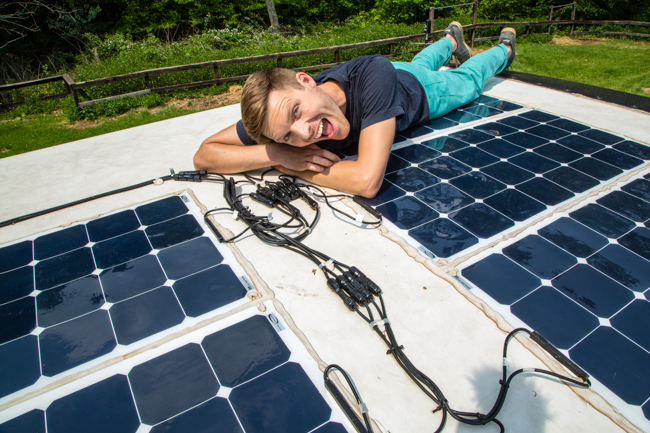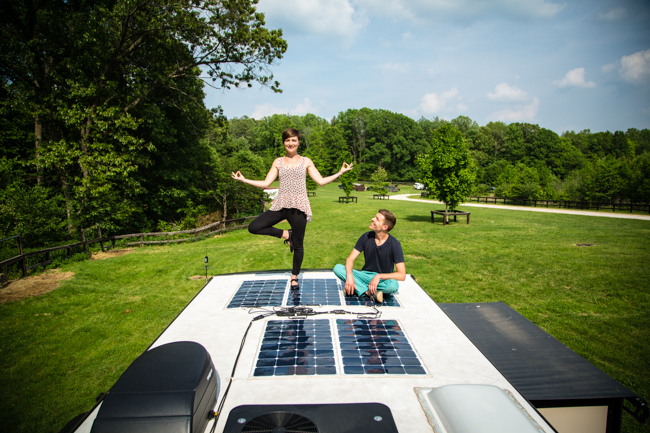Powerful and Flexible RV Solar Panels

If your RV plans include wild camping, or boondocking, then adding solar power to your rig is a must! With the spankin’ new flexible solar technology that’s just launched, installing solar panels is easier to do than ever…and for those who’ve been waiting for better solar technology you’re in luck since these new flexible panels are more efficient, lighter weight and extremely aerodynamic.

When we left Windy the RV (our Monaco Vesta) we decided to leave our 480 watt Solar Extreme Kit with her. When we moved into Roy the RV (our Fleetwood Excursion) we knew adding Solar Power would be one of our top priorities. We held off on solar the first few months of travel waiting for the brand new solar Flex Panels to be launched; it was worth the wait.
We ordered 500 watts of solar power for our roof, and honestly we could fit another 500 watts if we wanted to. Unfortunately Fleetwood has seen some of my How Not to Install videos so they requested we have a dealer do the install, so someone other than me would be liable for damages.
From the factory Roy came with a 2000 watt pure sine inverter with a built in smart charger so there was no reason to replace the inverter like we did with Windy. Roy also has 4 flooded type batteries on board which totals 464 amp hours (or “ah”). Its equivalent power to the battery bank we had with Windy but now we have a residential fridge which is kind of a power hog! (you can see all of our solar info here)

So now you’re caught up with our personal details let’s talk about why these new solar flex panels are better:
- Over 80% lighter weight than the tempered glass version of the panels and only 1/8” thin.
- Flexible making them more aerodynamic and allowing them to fit the curve of our roof (especially helpful for really curvy RV’s, vintage busses and Airstreams).
- 2% – 3% more efficient than the tempered glass monocrystalline solar panels and 2 times more efficient than the amorphous style “thin film” panels.
- Extremely durable so you can walk right on them, no more unsafe tippy-toeing around the panels on the roof.
The kit comes with a solar controller to monitor the batteries and prevent over charging. It displays the solar charge coming in, the current battery levels and of course the nifty power boost technology that tops up the batteries at the end of the day to keep us powered through the night.
Let’s talk potential downsides
We had a few questions and concerns before we installed these flex panels on the RV so we asked Go Power! and here’s what they said.
- Warranty – Why a 10 year warranty for the flex panels instead of the 25 year warranty like the glass panels?
This has to do with the ‘flexing’ of the panels. If someone decides NOT to permanently mount a Flex panel and keeps flexing it for years and years something’s going to give. The solar cells should last 30+ years if they are secured to the roof. - Heat – People are concerned about heat with traditional glass panels, and we’ve always said:
“The cooler the panel the higher the efficiency”. How does heat effect the flex panel when glued to the roof?
In extreme cases it’s going to lose some efficiency, but because we are using SunPower cells, which are one of the most efficient cells available, they are designed for high heat and low light applications so the loss would be minimal. As a rule of thumb just don’t stay too long in Death Valley in the middle of summer and you guys will be just fine 😉 - Tilting – Many people want to tilt, is this an option with the Flex Panels? The Flex panels are not really made for tilting, but they will conform to the shape of the roof. This is ideal say for Airstream owners because they can flex it out to the shape of the roof versus making special mounts that look ugly. Tilting is great if you’re RVing in the winter months when the sun is lower on the horizon, this allows more sun to hit the panels. On the other hand most people don’t want to go up on the roof and tilt up the panels throughout the day, and more importantly remember to bring them back down before they drive away! We really only recommend tilting to customers that are planning on RVing in the winter months and are going to be parked in the same location for two weeks or more. If they aren’t staying long in the same spot I recommend getting another panel, that usually makes up for the difference in power and they don’t have to do any extra work!
A little extra info on tilting: When you adjust / tilt the panel you only increase the solar performance by 5% (during summer months). The biggest benefit comes during the Winter months, where tilting the panel can increase performance up to 41%. Power output varies with time of year, weather and location. These percentages are calculated on assumed average winter hours in the Southern US.
After a short three months of use we’ve seen as much as 26 amps coming in on the solar controller…and we’re not even into summer yet.




